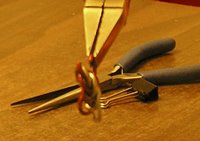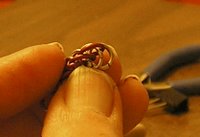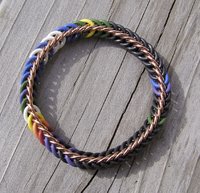starting half persian 4-in-1: a tutorial
How I start HP 4-in-1 — Illustrated with some rather inferior photography. The pictures are mostly pretty small and low-resolution. Clicking on them will get you a somewhat bigger, but not necessariy clearer, image.
There is only really one tricky place, where you insert the fifth ring and then hold onto things until you get the sixth ring in.
It's easiest to get used to if you use two different color rings. The finished weave has two crossed rows of rings. Each of the reds, in this example, is linked through 4 brights, but NEVER through another red, and vice versa. Except for putting the second red ring in, each ring is actually inserted through only two other rings, going through the eye of the previous two of the other row. The other two of the 4-in-1 get inserted into the current ring each time in the next couple of steps.

Start with all your rings open, except for three of one color. It is not had to do this weave with one complete set of closed rings, like rubber O-rings, but it's easier to learn by putting on one open ring at a time.
 Pick up the three closed brights and hang them on one red ring. Then flip one of the brights around, so that you have one in front of the others on the left side of the red, and two on the right side. They should make a diagonal stack, like a diagonally skewed stack of coins.
Pick up the three closed brights and hang them on one red ring. Then flip one of the brights around, so that you have one in front of the others on the left side of the red, and two on the right side. They should make a diagonal stack, like a diagonally skewed stack of coins.
 Bring the second red ring through the right-hand bright, back to front, then lead it back through the overlapping eye of the first two brights.
Bring the second red ring through the right-hand bright, back to front, then lead it back through the overlapping eye of the first two brights.  Keep this red ring completely above the first red ring; do not let it go through it. WITHOUT letting go of the little cluster of rings, brace the open red against the closed one and get it closed enough that it can't fall off. Do not let go the stack to pick up your other pliers, or it will be extremely hard to get them arranged again.
Keep this red ring completely above the first red ring; do not let it go through it. WITHOUT letting go of the little cluster of rings, brace the open red against the closed one and get it closed enough that it can't fall off. Do not let go the stack to pick up your other pliers, or it will be extremely hard to get them arranged again.
 Pick up another red ring. Insert it front to back in the eye of the second and third bright rings, keeping it horizontal and on top of the previous red. You will see by now that each color of rings makes an uninterrupted sort of sidewise stack, with the two rows of rings interpenetrating each other.
Pick up another red ring. Insert it front to back in the eye of the second and third bright rings, keeping it horizontal and on top of the previous red. You will see by now that each color of rings makes an uninterrupted sort of sidewise stack, with the two rows of rings interpenetrating each other.
 Now rotate the nascent chain slightly so that the bright rings are lying horizontally, making a sort of stair rising to the right. Pick up a new open bright and insert it in the eye of the rightmost two red rings, being careful not to let it go through the previous bright. By now it is safe to let go the chain to pick up pliers to properly close each ring as you insert it.
Now rotate the nascent chain slightly so that the bright rings are lying horizontally, making a sort of stair rising to the right. Pick up a new open bright and insert it in the eye of the rightmost two red rings, being careful not to let it go through the previous bright. By now it is safe to let go the chain to pick up pliers to properly close each ring as you insert it.
 Repeat the previous step with a red ring led through the eye of the last pair of brights, making sure the diagonal stack of reds continues unbroken.
Repeat the previous step with a red ring led through the eye of the last pair of brights, making sure the diagonal stack of reds continues unbroken.
 Then another bright ring is added. This photo shows a mistake. The bright ring is inserted properly through the eye of the reds, but it is also slipping through the previous bright. No ring should ever go through one of its own color (or through its own row, if you are making a solid-color chain).
Then another bright ring is added. This photo shows a mistake. The bright ring is inserted properly through the eye of the reds, but it is also slipping through the previous bright. No ring should ever go through one of its own color (or through its own row, if you are making a solid-color chain).
 Slide the tip of the bright ring back out of the other bright, and close it properly.
Slide the tip of the bright ring back out of the other bright, and close it properly.
 Continue adding red rings and bright rings alternately. The pattern of half persian 4-in-1 is very bold and definite, so if you keep an eye on your work it should be obvious quickly if you have gotten a ring in improperly.
Continue adding red rings and bright rings alternately. The pattern of half persian 4-in-1 is very bold and definite, so if you keep an eye on your work it should be obvious quickly if you have gotten a ring in improperly.
 This is the chain made from the 15 rings that were originally shown on the table at the beginning of this tut. These particular rings - aluminum 1/4" rings from The Ring Lord - are a bit tight for this weave. It is not difficult to weave, but the chain has almost no flexibility.
This is the chain made from the 15 rings that were originally shown on the table at the beginning of this tut. These particular rings - aluminum 1/4" rings from The Ring Lord - are a bit tight for this weave. It is not difficult to weave, but the chain has almost no flexibility.
 This last photo shows 15 more rings added to the chain in the Forars Kaede variant. Here the continuous diagonal stack formed by each row of rings is not done; instead the rings are inserted alternately above and below the preceding one of the row. For the same rings, this chain is slightly more flexible. This chain has an extremely limited AR to work properly. This particular example holds its arrangement perfectly well. But if the rings are just slightly larger or skinnier, they can slip past each other in their placement in the eye, so that the pattern of Vs is no longer clear.
This last photo shows 15 more rings added to the chain in the Forars Kaede variant. Here the continuous diagonal stack formed by each row of rings is not done; instead the rings are inserted alternately above and below the preceding one of the row. For the same rings, this chain is slightly more flexible. This chain has an extremely limited AR to work properly. This particular example holds its arrangement perfectly well. But if the rings are just slightly larger or skinnier, they can slip past each other in their placement in the eye, so that the pattern of Vs is no longer clear.
I will try to describe doing a stretchy half-rubber 4-in-1 later. Basically, you follow these directions, using O-rings for the brights. Start with three rubber rings on a metal ring. Add the second metal ring as shown with the second red above, except that it has to already have a rubber ring hanging from it as you insert it. Then just repeat that step, putting a metal ring through a single rubber edge, then back through a rubber eye.
There is only really one tricky place, where you insert the fifth ring and then hold onto things until you get the sixth ring in.
It's easiest to get used to if you use two different color rings. The finished weave has two crossed rows of rings. Each of the reds, in this example, is linked through 4 brights, but NEVER through another red, and vice versa. Except for putting the second red ring in, each ring is actually inserted through only two other rings, going through the eye of the previous two of the other row. The other two of the 4-in-1 get inserted into the current ring each time in the next couple of steps.

Start with all your rings open, except for three of one color. It is not had to do this weave with one complete set of closed rings, like rubber O-rings, but it's easier to learn by putting on one open ring at a time.
 Pick up the three closed brights and hang them on one red ring. Then flip one of the brights around, so that you have one in front of the others on the left side of the red, and two on the right side. They should make a diagonal stack, like a diagonally skewed stack of coins.
Pick up the three closed brights and hang them on one red ring. Then flip one of the brights around, so that you have one in front of the others on the left side of the red, and two on the right side. They should make a diagonal stack, like a diagonally skewed stack of coins. Bring the second red ring through the right-hand bright, back to front, then lead it back through the overlapping eye of the first two brights.
Bring the second red ring through the right-hand bright, back to front, then lead it back through the overlapping eye of the first two brights.  Keep this red ring completely above the first red ring; do not let it go through it. WITHOUT letting go of the little cluster of rings, brace the open red against the closed one and get it closed enough that it can't fall off. Do not let go the stack to pick up your other pliers, or it will be extremely hard to get them arranged again.
Keep this red ring completely above the first red ring; do not let it go through it. WITHOUT letting go of the little cluster of rings, brace the open red against the closed one and get it closed enough that it can't fall off. Do not let go the stack to pick up your other pliers, or it will be extremely hard to get them arranged again. Pick up another red ring. Insert it front to back in the eye of the second and third bright rings, keeping it horizontal and on top of the previous red. You will see by now that each color of rings makes an uninterrupted sort of sidewise stack, with the two rows of rings interpenetrating each other.
Pick up another red ring. Insert it front to back in the eye of the second and third bright rings, keeping it horizontal and on top of the previous red. You will see by now that each color of rings makes an uninterrupted sort of sidewise stack, with the two rows of rings interpenetrating each other. Now rotate the nascent chain slightly so that the bright rings are lying horizontally, making a sort of stair rising to the right. Pick up a new open bright and insert it in the eye of the rightmost two red rings, being careful not to let it go through the previous bright. By now it is safe to let go the chain to pick up pliers to properly close each ring as you insert it.
Now rotate the nascent chain slightly so that the bright rings are lying horizontally, making a sort of stair rising to the right. Pick up a new open bright and insert it in the eye of the rightmost two red rings, being careful not to let it go through the previous bright. By now it is safe to let go the chain to pick up pliers to properly close each ring as you insert it. Repeat the previous step with a red ring led through the eye of the last pair of brights, making sure the diagonal stack of reds continues unbroken.
Repeat the previous step with a red ring led through the eye of the last pair of brights, making sure the diagonal stack of reds continues unbroken. Then another bright ring is added. This photo shows a mistake. The bright ring is inserted properly through the eye of the reds, but it is also slipping through the previous bright. No ring should ever go through one of its own color (or through its own row, if you are making a solid-color chain).
Then another bright ring is added. This photo shows a mistake. The bright ring is inserted properly through the eye of the reds, but it is also slipping through the previous bright. No ring should ever go through one of its own color (or through its own row, if you are making a solid-color chain). Slide the tip of the bright ring back out of the other bright, and close it properly.
Slide the tip of the bright ring back out of the other bright, and close it properly. Continue adding red rings and bright rings alternately. The pattern of half persian 4-in-1 is very bold and definite, so if you keep an eye on your work it should be obvious quickly if you have gotten a ring in improperly.
Continue adding red rings and bright rings alternately. The pattern of half persian 4-in-1 is very bold and definite, so if you keep an eye on your work it should be obvious quickly if you have gotten a ring in improperly. This is the chain made from the 15 rings that were originally shown on the table at the beginning of this tut. These particular rings - aluminum 1/4" rings from The Ring Lord - are a bit tight for this weave. It is not difficult to weave, but the chain has almost no flexibility.
This is the chain made from the 15 rings that were originally shown on the table at the beginning of this tut. These particular rings - aluminum 1/4" rings from The Ring Lord - are a bit tight for this weave. It is not difficult to weave, but the chain has almost no flexibility. This last photo shows 15 more rings added to the chain in the Forars Kaede variant. Here the continuous diagonal stack formed by each row of rings is not done; instead the rings are inserted alternately above and below the preceding one of the row. For the same rings, this chain is slightly more flexible. This chain has an extremely limited AR to work properly. This particular example holds its arrangement perfectly well. But if the rings are just slightly larger or skinnier, they can slip past each other in their placement in the eye, so that the pattern of Vs is no longer clear.
This last photo shows 15 more rings added to the chain in the Forars Kaede variant. Here the continuous diagonal stack formed by each row of rings is not done; instead the rings are inserted alternately above and below the preceding one of the row. For the same rings, this chain is slightly more flexible. This chain has an extremely limited AR to work properly. This particular example holds its arrangement perfectly well. But if the rings are just slightly larger or skinnier, they can slip past each other in their placement in the eye, so that the pattern of Vs is no longer clear.I will try to describe doing a stretchy half-rubber 4-in-1 later. Basically, you follow these directions, using O-rings for the brights. Start with three rubber rings on a metal ring. Add the second metal ring as shown with the second red above, except that it has to already have a rubber ring hanging from it as you insert it. Then just repeat that step, putting a metal ring through a single rubber edge, then back through a rubber eye.





